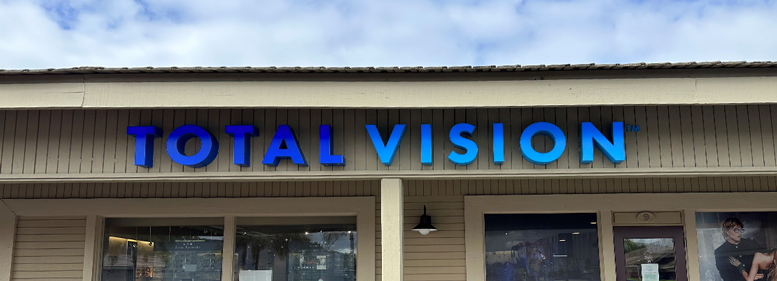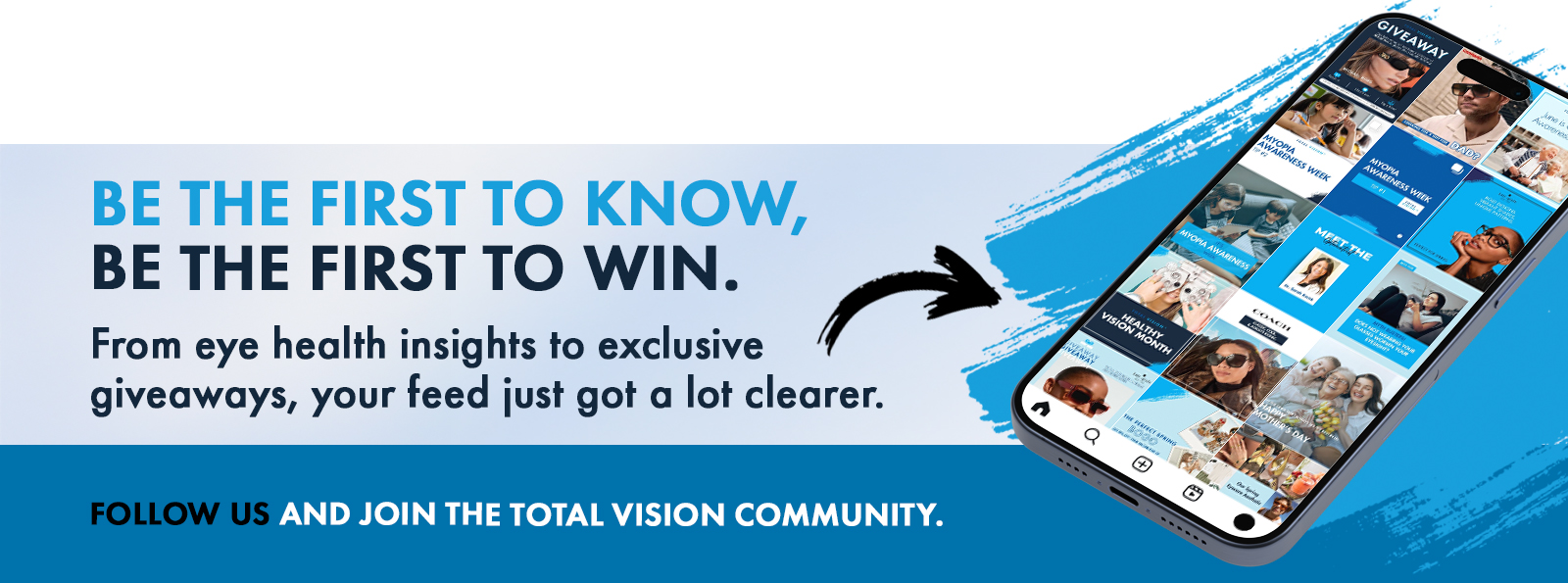Support Your Child’s Visual Growth With Total Vision Sports Arena
Even before your baby learns to reach out with their hands, they use their eyes to explore and interact with the world around them. Their eyes play an essential role in their overall development, sending them the information they need to grow and learn.
Your child’s eyes grow exponentially in early childhood. Eye problems can develop quickly and with very little notice. Since vision problems in infants can lead to developmental delays, pediatric eye exams are essential tools for protecting your child’s overall growth and development.
At Total Vision Sports Arena, our eye care team knows how to make an eye exam a special experience for your child. Our tests are non-invasive, and our optometrists are calm and compassionate. We’ll also always make sure you know exactly what every test does and what the results mean. Your child is in good hands at Total Vision Sports Arena. Please book their eye care appointment today.

When Does My Child Need an Eye Exam?
Every children’s eye exam at our clinic involves assessing your child’s visual skills, eye movements, refraction, and overall eye health. Our ultimate goal is to ensure your child is reaching their major visual milestones as expected and to uncover any red flags that could indicate a problem.
The American Optometric Association recommends that every child undergo an eye exam, no matter how healthy their eyes seem, at specific moments in their development.
1 to 3 Years Old
Even if there’s no sign of an eye problem, your baby should have an eye exam when they are 1 year old. Your optometrist will check for refractive errors like nearsightedness, farsightedness, and astigmatism, eye movement ability and eye alignment, as well as their overall eye health.
They’ll also check how your child’s visual skills are developing. During their first year, your baby will begin to gain eye-hand coordination, tracking, binocular vision, depth perception, and color vision.
Preschool Children
Children should undergo another thorough eye exam between the ages of 3 and 5. Your optometrist will make sure your toddler’s eyes are still developing correctly and check for evidence of eye disease.
Common childhood vision problems like amblyopia and strabismus may develop around these years. Children won’t outgrow these vision problems, and so they need proper treatment to prevent long-term eye-related issues.
An eye exam before your child enters school gives your optometrist the chance to prescribe treatment plans or corrective lenses to help your child achieve their clearest vision possible.
School-Aged Children
Once your child enters school, annual eye exams are the best way to support healthy vision and ensure their eyes won’t hold them back.
Your growing child’s eyes will be taxed more and more as they progress through their grades. From homework, reading, whiteboard work, and computer work, your child relies on their visual skills to interpret and understand the things their eyes process.
Routine back-to-school eye exams give your child the support they need to succeed in vision-related learning, which is 80% of all their learning!
Common Pediatric Eye Conditions
Amblyopia (Lazy Eye)
Amblyopia, commonly known as “lazy eye,” occurs when there is poor vision development in one eye. It happens because there’s an issue in how the eyes and the brain work together. For some reason, the brain can’t interpret information sent from the weaker eye.
Amblyopia most often begins in childhood and is the most common cause of vision loss in children. Fortunately, treatment is often effective at improving vision in the weaker eye and preventing long-term vision problems.
Strabismus (Crossed Eyes)
Strabismus, also known as “crossed eyes,” is a vision problem that occurs when the eyes look in 2 different directions simultaneously. It can be caused by a problem with the eye muscles, the nerves that control the eye muscles, or the brain.
If strabismus is left untreated, it can lead to reduced vision in the turned eye. While strabismus can’t be prevented, complications associated with untreated strabismus can be avoided if the condition is diagnosed and treated early enough.
Conjunctivitis (Pink Eye)
Conjunctivitis, or “pink eye,” is the inflammation of the conjunctiva, the transparent membrane that covers the eyes and inner eyelids. When the conjunctiva’s blood vessels become inflamed, they turn the red or pink color that gives this condition its nickname.
Contagious conjunctivitis is common in children, and outbreaks are frequent in schools and daycares. The most common causes of childhood conjunctivitis are:
- Bacterial infections
- Viral infections
- Allergies
Bacterial and viral conjunctivitis are very contagious, while allergic conjunctivitis isn’t. Each type of pink eye requires a specific treatment. It’s important to take your child to see their optometrist if you suspect they have pink eye.
Book a Children’s Eye Exam Today
Support your child’s development by booking them for a routine pediatric eye exam at Total Vision Sports Arena today!
Our Location
We’re conveniently located off Sports Arena Boulevard, right next door to Phil’s BBQ in the Midway District. There’s tons of parking and an accessible stall right in front of our door. Same day appointments available! Welcoming new patients.

Our Address
- 3750 Sports Arena Blvd.,
Suite 9 - San Diego, CA 92110
Contact Information
- Phone: 619.224.2879
- Email: [email protected]
Our Hours
- Monday: 8:00 AM – 5:00 PM
- Tuesday: 8:00 AM – 5:00 PM
- Wednesday: 9:00 AM – 6:00 PM
- Thursday: 8:00 AM – 5:00 PM
- Friday: 8:00 AM – 5:00 PM
- Saturday: Closed
- Sunday: Closed
Our Eye Care Services
Our Brands




Our Google Reviews

Our Blog
Can You Feel Contact Lenses in Your Eyes?
Contact LensesWith proper contact lens wear and care habits, you should not be able to feel them in your eyes. If you notice the contact in your eye, this could stem from several reasons:
Improper fit or size
Dry eye
Lens positioning
Extensive wear
Poor contact lens hygiene […]
How to Relieve Extreme Dry Eyes at Night
Eye HealthFrom simple solutions to advanced therapies, there are several ways you can effectively relieve extreme dry eyes at night:
Creating a hydrating sleep environment: Humidifier, drinking water, and adjusting room temperature
Protecting your eyes: Sleep mask, warm compress mask, artificial tears, eye ointment, and limiting screen time
Advanced dry eye therapies: Prescription eye drops and punctal plugs
[…]
How to Prevent Retinal Detachment
Eye HealthRetinal detachment can often be prevented. Protecting your eyes at all times, following a healthy lifestyle, and regular eye exams are essential steps. It also helps to know the signs of something wrong so you can seek immediate help when needed. […]
Can You Feel Contact Lenses in Your Eyes?

With proper contact lens wear and care habits, you should not be able to feel them in your eyes. If you notice the contact in your eye, this could stem from several reasons:
Improper fit or size
Dry eye
Lens positioning
Extensive wear
Poor contact lens hygiene […]
How to Relieve Extreme Dry Eyes at Night

From simple solutions to advanced therapies, there are several ways you can effectively relieve extreme dry eyes at night:
Creating a hydrating sleep environment: Humidifier, drinking water, and adjusting room temperature
Protecting your eyes: Sleep mask, warm compress mask, artificial tears, eye ointment, and limiting screen time
Advanced dry eye therapies: Prescription eye drops and punctal plugs
[…]
How to Prevent Retinal Detachment

Retinal detachment can often be prevented. Protecting your eyes at all times, following a healthy lifestyle, and regular eye exams are essential steps. It also helps to know the signs of something wrong so you can seek immediate help when needed. […]



